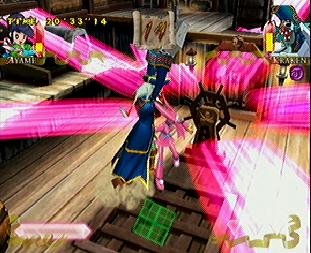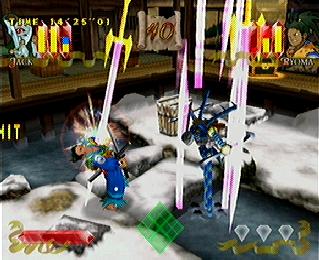I have the power!!
The 19th century was a difficult one. France started the century off with a good
deal of bloodshed thanks to a short fellow named Napoleon. The United States had
a civil war. Japan was forced to open itself up to the outside world. China and
Britain clashed in the Opium War. And somewhere, hidden on the secret isle of
Avalon (Mystical resting place of King Arthur), lay the Powerstone, a precious
jewel that had the ability to grant one wish. Fighters from around the world were
given a taste of the Powerstone and felt drawn to battle each other in
order to control its power. I wonder if you can wish for more wishes?
Capcom, the father of fighting games, has made its debut on the Dreamcast with
a fighting game unlike its very popular Street Fighter series. Instead
of the typical two dimensional side view fare that we’ve come to expect from
a Capcom fighter, Powerstone takes advantage of the Dreamcast’s amazing
polygonal engine to bring you a fighting game where the environment is as important
as the fighters themselves. With numerous characters, fast-paced action, and
a variety of weapons to choose from, Powerstone is a strong title for
the new system.
As you might expect from a Dreamcast game, the graphics are smooth and crisp.
Though Capcom decided to still use two dimensional anime-style pictures of the
characters for the opening movie, there isn’t a sprite to be found once you
start the game. Everything is polygonal, including the characters, arenas, and
all the different weapons. And for good reason, too . . .
Powerstone can best be compared to Super
Smash Bros. for the N64. Instead of relying on a ton of individual moves
for each character, the focus is shifted to how the characters interact with
the environment. Each arena has a number of weapons laying around, but don’t
think you’re limited to just using those. Anything can be a weapon, from the
pillar in the middle of the room to the ceiling fan on the roof above.
The arenas themselves are unlike anything you’ve seen before. Where Super
Smash Bros. presented polygonal characters fighting in a two dimensional
field, Powerstone uses an isometric vantage point. You can not only jump
on platforms to get the vertical drop on your opponent, but also move in and
out of the screen attacking from odd angles. Worried you’re going to get beaten?
Try climbing up a tree to escape your opponent’s flying fists.
 Battles are most often decided,
Battles are most often decided,
however, by the person who controls the Powerstone. Each round, each
character starts with one colored Powerstone, while a third appears in
the arena about 10 seconds into the round. Characters can steal each other’s
stones by beating each other up. Once a character collects all three stones,
they transform into a more powerful being. When your opponent transforms, there’s
only one thing to do . . . run. With some epic, over-the-top moves that utterly
devastate the enemy, the use of the Powerstone is a neat new addition
that makes think while you’re playing.
While the weapon and object interaction is neat, the basic moves of the characters
leave a little to be desired. The moves are so simplistic that anyone can pick
up the game and kick some butt without much practice. While fine for beginners,
it lacks the depth that most fighting games have. Very few gamers are going
to spend hours upon hours playing it (*cough* Soul
Calibur *cough*).
Powerstone is a fast-paced fighting game that’s sure to entertain almost
every gamer. With plenty of weapons, well-designed arenas, and the excellent
implementation of the Powerstone during the battles, this is a refreshing
new game from Capcom. Though more advanced gamers might wish that there were
some more complicated moves, the ease of Powerstone makes it great for
multi-player. This is a strong title and a great addition to the launch
of the Sega Dreamcast.

-
Good Arenas
-
Amazing Object Interaction
-
Powerstone Powerups
-
Simplistic Moves







